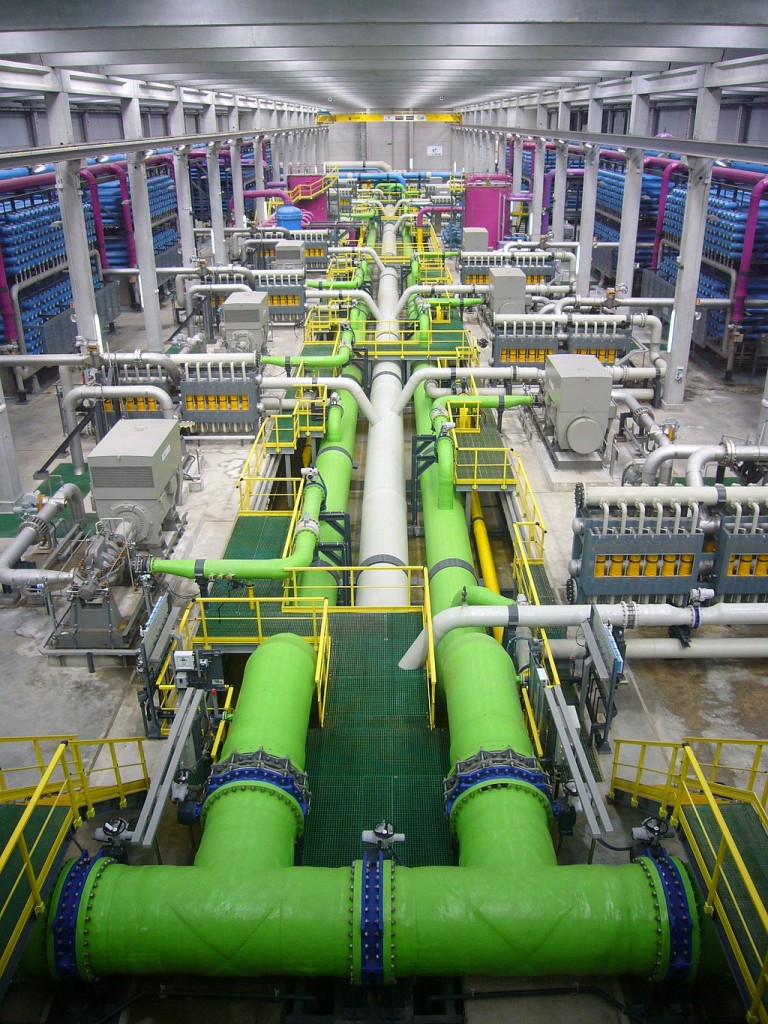by Amanda Pebler, Communications Intern
When discussing the current drought in California, there is often talk of desalination and its potential to increase our freshwater supply. Desalination, the process of removing salt and minerals from saline water, seems like an obvious solution to the drought and ongoing water scarcity concerns because it is a reliable, drought-proof water source. Indeed, fourteen new desalination plants have been proposed along the California coast and one is under development in Carlsbad. For many, this may seem like an answer to the “exceptional drought”. As consumers, it may also seem like a way to help us avoid making lifestyle changes, such as Governor Jerry Brown’s call for Californians to reduce their water use by 20 percent. But while desalination may be a reliable option, the answer is much more complicated.
One of the greatest issues with desalination is the cost associated with these projects. A new plant may cost upwards of hundreds of millions of dollars to build (a billion in the case of the Carlsbad facility), plus considerable cost to run the plant.
 Beyond the costs to build these facilities, operational costs are substantial and raise concerns over the energy requirements and their impacts. Energy costs make up around a third of total operating costs for a typical desalination plant. In California, there is concern about vulnerability to short-term and long-term energy price increases. During a drought, energy prices tend to increase due to the reduced ability to generate hydropower and the need to replace that hydropower with more expensive energy sources. These costs are often overlooked and not always factored into the total project cost. Long term, energy prices are not static and may increase due to the rising costs of developing renewable alternatives and building and maintaining new and existing infrastructure.
Beyond the costs to build these facilities, operational costs are substantial and raise concerns over the energy requirements and their impacts. Energy costs make up around a third of total operating costs for a typical desalination plant. In California, there is concern about vulnerability to short-term and long-term energy price increases. During a drought, energy prices tend to increase due to the reduced ability to generate hydropower and the need to replace that hydropower with more expensive energy sources. These costs are often overlooked and not always factored into the total project cost. Long term, energy prices are not static and may increase due to the rising costs of developing renewable alternatives and building and maintaining new and existing infrastructure.
With these high capital and operational costs also comes a higher cost of its product, water. Desalinated water can cost upwards of $1,900 per acre foot, considerably more than other alternatives such as water conservation and efficiency, stormwater capture, and recycled water.
Aside from the costs, there are other potential externalities associated with desalination facilities, including environmental impacts. Seawater intake systems that draw ocean water in through screened pipes impinge marine organisms on the intakes. Smaller organisms able to pass through, such as eggs, larvae, and plankton, are entrained into the plant and killed during the desalination process. Produced water disposal can also have a substantial threat to marine life. The salt is concentrated into a brine that is usually pumped back out to sea for disposal after going through the desalination process. These point sources increase salinity levels and may affect local sea life, depending on the plant’s location and sea currents.
The idea of building seawater desalination plants during a drought is not a new one. In 1991, a desalination plant in Santa Barbara was constructed in response to the 1987-1992 drought. Once the plant was completed, abundant rainfall rendered the plant cost-inefficient, and it shut down in 1992. Currently, costs to restart the plant are being assessed as the technology and infrastructure are dated and would incur new capital investment. Likewise, six seawater desalination plants were built in Australia in response to the Millennium Drought. Today, four out of the six plants are left idle due to the availability of cheaper alternatives. These examples should serve as cautionary tales.
The good news is that we still have cost-effective options readily available. A new study by the Pacific Institute and NRDC shows how California’s drought can be managed with better allocation and management of water resources. By implementing water-saving practices, water reuse, and stormwater capture, California can save 5.2 to 7.1 million acre-feet of water each year in our urban areas – equivalent to the output of 125 large desalination plants!
Sustainable water management is best served by creating a comprehensive water management strategy in California, one that captures the most cost-effective options first. California has the ability to bridge the gap between water demand and supply by taking advantage of the existing resources and practices that have yet to be fully and efficiently harnessed.
Pacific Institute Insights is the staff blog of the Pacific Institute, one of the world’s leading nonprofit research groups on sustainable and equitable management of natural resources. For more about what we do, click here. The views and opinions expressed in these blogs are those of the authors and do not necessarily reflect an official policy or position of the Pacific Institute.


